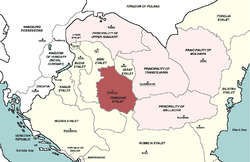Temeşvar Eyalet
| Eyalet of Temeşvar Eyâlet-i Tımışvar Eialetul Timişoarei Temišvarski ejalet Temesvári vilajet Eyālet-i Tımışvar | |||||
| Eyalet of the Ottoman Empire | |||||
| |||||
 | |||||
| Capital | Tımışvar[1] (Romanian: Timişoara) and Yanova[2] (Romanian: Ineu) 45°45′N 21°13′E / 45.750°N 21.217°ECoordinates: 45°45′N 21°13′E / 45.750°N 21.217°E | ||||
| History | |||||
| • | Established | 1552 | |||
| • | Austro-Turkish War of 1716–1718 | 1716 | |||
| Today part of | | ||||


The Eyalet of Temeşvar (Ottoman Turkish: ایالت تمشوار; Eyālet-i Tımışvār),[3] known as Eyalet of Yanova after 1658,[4] was a first-level administrative unit (eyalet) of the Ottoman Empire located in the Banat region of Central Europe.
Besides Banat, the province also included area north of the Mureş River, part of the Crişana region. Its territory is now divided between Hungary, Romania, and Serbia. Its capital was Temeşvar (Romanian: Timişoara).
Names
The name of the province in Ottoman Turkish was Eyâlet-i Temeşvar or Eyâlet-i Tımışvar (in Modern Turkish: Temeşvar Eyaleti or Tamışvar Eyaleti), in Hungarian was Temesvári vilajet, in Romanian was Eialetul Timişoarei or Paşalâcul Timişoara, in Serbian was Темишварски ејалет or Temišvarski ejalet. The province was named after its administrative seat, Temeşvar. The Turkish name Temeşvar is given after the Hungarian one, Temesvár meaning "Castle on the Temes" (River).
History
The Eyalet of Temeşvar was formed in 1552, when the Hungarian castle of Temesvár defended by the troop of István Losonczy was captured by the Ottoman troops led by Kara Ahmed Pasha in July 26, 1552[5] and existed until 1716, when it was conquered by the Habsburg Monarchy. The Eyalet was led by a vali (governor) or beylerbey (sometimes with position of pasha or vizir), whose residence was at the former Hunyadi Castle in Temeşvar. In 1718, the Habsburgs formed a new province in this region, named the Banat of Temeswar.
 Eyalet of Temeşvar and Banate of Lugos and Karansebes in 1568
Eyalet of Temeşvar and Banate of Lugos and Karansebes in 1568 Temeşvar Eyalet, mid-17th century
Temeşvar Eyalet, mid-17th century Eyalet of Temeşvar in 1699
Eyalet of Temeşvar in 1699 Map from 1700 (Eyalet of Temeşvar depicted in red)
Map from 1700 (Eyalet of Temeşvar depicted in red)
Administrative divisions
Before the Treaty of Karlowitz in 1699, the province was divided into following sanjaks:[6]
Sanjaks of Arad, Küle, Yanova, Fenlak and northern parts of the Çanad and Lipva sanjaks were transferred to Habsburg Monarchy after signing of the Treaty of Karlowitz. |
The eyalet consisted of five sanjaks between 1700 and 1701:[7]
Note: Before the Treaty of Karlowitz, Sanjak of Segedin was part of the Egir Eyalet. Most of this sanjak (including its administrative center, Segedin) was transferred to the Habsburg Monarchy in 1699. Small eastern part of the sanjak on the left bank of the river Tisa remained within Ottoman Empire. |
According to Sancak Tevcih Defteri, the eyalet consisted of six sanjaks between 1701 and 1702:[7][8]
|
The eyalet consisted of three sanjaks between 1707 and 1713:[7]
|
Governors
- Kazim-bey or Gazi Kasim-pasha (1552–1554)[9]
- Hasan-pasha (1594)[10]
- Sofi Sinan-pasha (1594)[11]
- Hasan-pasha, the younger (1594)[12]
- Mustafa Pasha (fl. July 1594)
- Dželalija Hasan-paša (–1605)
- Ahmed-paša Dugalić (1605–)
- Ibrahim-pasha (1687)[13]
- Ibrahim-pasha (1701-)[14]
See also
References
- ↑ Halil Inaldžik, Osmansko carstvo, Beograd, 2003, page 166.
- ↑ Narrative of travels in Europe, Asia, and Africa in the ..., Volume 1, p. 92, at Google Books By Evliya Çelebi, Joseph von Hammer-Purgstall
- ↑ "Some Provinces of the Ottoman Empire". Geonames.de. Retrieved 25 February 2013.
- ↑ Osman Okyar; Hali̇l İnalcık (1980). Türkiye'nin Sosyal Ve Ekonomik Tarihi, 1071-1920: Birinci Uluslararası Türkiye'nin Sosyal Ve Ekonomik Tarihi Kongresi Tebliğleri. Meteksan. p. 68. Retrieved 3 June 2013.
eyalet d'Ineu (Yanova) —nom donné après 1658 à l'eyalet de Temesvar
- 1 2 Sadık Müfit Bilge, "Macaristan'da Osmanlı Hakimiyetinin ve İdarî Teşkilatının Kuruluşu ve Gelişmesi", Ankara Üniversitesi Osmanlı Tarihi Araştırma ve Uygulama Merkezi Dergisi (OTAM), Sayı: 11 Sayfa: 033-081, 2000, p. 59. (in Turkish)
- ↑ Dr Dušan J. Popović, Srbi u Vojvodini, knjiga I, Novi Sad, 1990, p. 201.
- 1 2 3 Orhan Kılıç, XVII. Yüzyılın İlk Yarısında Osmanlı Devleti'nin Eyalet ve Sancak Teşkilatlanması, Osmanlı, Cilt 6: Teşkilât, Yeni Türkiye Yayınları, Ankara, 1999, ISBN 975-6782-09-9, p. 92. (in Turkish)
- ↑ Orhan Kılıç, XVII. Yüzyılın İlk Yarısında Osmanlı Devleti'nin Eyalet ve Sancak Teşkilatlanması, Osmanlı, Cilt 6: Teşkilât, Yeni Türkiye Yayınları, Ankara, 1999, ISBN 975-6782-09-9, p. 91. (in Turkish)
- ↑ Milan Tutorov, Banatska rapsodija, Novi Sad, 2001, page 151.
- ↑ Milan Tutorov, Banatska rapsodija, Novi Sad, 2001, page 194.
- ↑ Milan Tutorov, Banatska rapsodija, Novi Sad, 2001, page 195.
- ↑ Milan Tutorov, Banatska rapsodija, Novi Sad, 2001, page 198.
- ↑ Milan Tutorov, Banatska rapsodija, Novi Sad, 2001, page 232.
- ↑ Milan Tutorov, Banatska rapsodija, Novi Sad, 2001, page 249.
Further reading
- Dr. Dušan J. Popović, Srbi u Vojvodini, knjiga 1, Novi Sad, 1990.
- Milan Tutorov, Banatska rapsodija, Novi Sad, 2001.
External links
- Province of Temeşvar in 1600 - Map
- Province of Temeşvar in 1700 - Map
- Province of Temeşvar - Map
- Province of Temeşvar - Map
- Province of Temeşvar - Map
